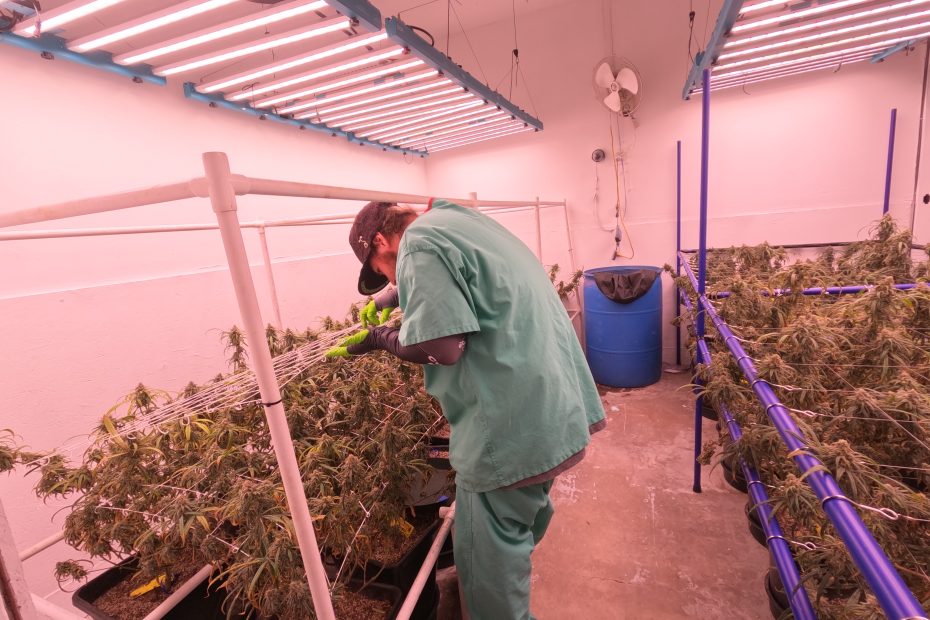Part: 3
Hazards of Trellis Netting in Cannabis Cultivation: Ergonomic Challenges and Safety Considerations

Ergonomic Hazards of Trellis Netting
When exploring the hazards of trellis netting in cannabis cultivation, ensuring worker safety in the erection, maintenance, and removal of trellis netting plays a crucial role in cannabis cultivation. Providing support for plants and optimizing space utilization is important, but so are your people.
The use of trellis netting can present ergonomic challenges that may impact worker health and safety. Let’s examine the specific hazards related to the erection, maintenance, and removal of trellis netting in cannabis cultivation.
- Musculoskeletal Disorders (MSDs):
- Awkward Postures: Erection and maintenance of trellis netting often require workers to adopt awkward positions. These may include tasks such as reaching overhead or bending for extended periods. These repetitive movements and sustained postures can lead to musculoskeletal disorders, including strains, sprains, and back pain.
- Overexertion: The physical effort involved in handling and stretching trellis netting can place significant strain on workers’ muscles and joints, increasing the risk of overexertion injuries.
- Sharp Tools and Cuts:
- Use of Cutting Tools: Sharp tools like scissors or utility knives are commonly employed to trim or cut trellis netting during installation or removal. Inadequate training or improper handling of these tools can result in accidental cuts or puncture wounds.
- Hazardous Debris: When removing trellis netting, broken or damaged strands may pose additional risks, potentially causing lacerations or abrasions if workers come into contact with the sharp edges or protruding wires.
- Repetitive Motion Injuries:
- Continuous Manual Labor: The erection, maintenance, and removal of trellis netting can involve repetitive motions, such as stretching, pulling, or tying knots. Performing these tasks repeatedly without proper rest or ergonomic considerations can lead to repetitive motion injuries, such as tendonitis or bursitis.
Mitigation Measures for Safety and Ergonomics
To mitigate the hazards associated with trellis netting in cannabis cultivation, it is essential to implement proper safety protocols and ergonomic practices. Here are some recommendations:
- Training and Education:
- Provide comprehensive training on ergonomic practices, including proper lifting techniques, posture awareness, and safe tool handling.
- Educate workers on the potential hazards of trellis netting and the importance of using personal protective equipment (PPE), such as gloves and eye protection.
- Ergonomic Equipment and Tools:
- Provide workers with ergonomically designed tools and equipment that reduce strain on muscles and joints during netting installation, maintenance, and removal.
- Implement ergonomic workstations and adjustable height platforms to minimize awkward postures and support proper body mechanics.
- Work Practices and Rotation:
- Encourage regular breaks and task rotation to prevent overexertion and repetitive motion injuries.
- Promote stretching exercises and warm-up routines to prepare workers’ muscles before engaging in netting-related tasks.
Prioritizing Worker Safety in Trellis Netting Operations
In cannabis cultivation, the use of trellis netting is essential for plant support and optimal growth. However, it is crucial to acknowledge and address the hazards associated with erecting, maintaining, and removing trellis netting. By implementing proper training, providing ergonomic equipment, and promoting safe work practices, cannabis cultivators can prioritize the well-being of workers, minimize ergonomic risks, and foster a safer working environment.
Green Tree SCROG – A Superior System
We’ve addressed scrogging in other articles and have covered in depth how plants benefit from this method of growing. Now it’s time to address the human factor. When considering all factors we must further address the human benefits.
- Reduced Physical Strain:
- Green Tree SCROG is designed with user-friendly features, potentially minimizing physical strain on cultivators. The ergonomic design of the system, including adjustable components and accessible interfaces, can contribute to a more comfortable and less physically demanding cultivation experience.
- Improved Posture:
- Equally important, ergonomics plays a crucial role in promoting proper posture during cultivation activities. Green Tree SCROG’s design considerations contribute to improved posture by providing convenient access to plants at various stages of growth. This could reduce the likelihood of discomfort or strain associated with extended periods of bending or reaching.
- Enhanced Productivity:
- An ergonomically designed system can streamline cultivation tasks, potentially leading to increased productivity. With features that facilitate efficient plant management, such as easy access to individual plants for pruning or training, Green Tree SCROG allows cultivators to complete tasks more effectively, contributing to a healthier workflow.
- Minimized Repetitive Stress Injuries:
- Repetitive stress injuries are common concerns in agriculture and cultivation. Green Tree SCROG’s design, if optimized for ergonomic considerations, may reduce the risk of repetitive stress injuries by minimizing the need for repetitive motions that can lead to strain on joints and muscles.
- Promotion of Overall Well-being:
- A well-designed cultivation system not only benefits physical health but can also contribute to the overall well-being of cultivators. By incorporating ergonomic principles into its design, Green Tree SCROG creates a more enjoyable and sustainable cultivation experience, potentially reducing stress and fatigue associated with manual cultivation methods.
Next, It’s important to note that the specific ergonomic and health benefits would depend on the features and design considerations implemented in your grow. For detailed and accurate information, refer to the website.
References:
- National Institute for Occupational Safety and Health (NIOSH). (2015). Health Hazard Evaluation Report: Evaluation of Musculoskeletal
